PACAP/VIP and receptor characterization in micturition pathways in mice with overexpression of NGF in urothelium
- PMID: 20449688
- PMCID: PMC2955834
- DOI: 10.1007/s12031-010-9384-3
PACAP/VIP and receptor characterization in micturition pathways in mice with overexpression of NGF in urothelium
Abstract
Urothelium-specific overexpression of nerve growth factor (NGF) in the urinary bladder of transgenic mice stimulates neuronal sprouting or proliferation in the urinary bladder, produces urinary bladder hyperreflexia, and results in increased referred somatic hypersensitivity. Additional NGF-mediated changes might contribute to the urinary bladder hyperreflexia and pelvic hypersensitivity observed in these transgenic mice such as upregulation of neuropeptide/receptor systems. Chronic overexpression of NGF in the urothelium was achieved through the use of a highly urothelium-specific, uroplakin II promoter. In the present study, we examined pituitary adenylate cyclase activating polypeptide (PACAP), vasoactive intestinal polypeptide (VIP), and associated receptor (PAC1, VPAC1, VPAC2) transcripts or protein expression in urothelium and detrusor smooth muscle and lumbosacral dorsal root ganglia in NGF-overexpressing and littermate wildtype mice using real-time quantitative reverse transcription-polymerase chain reaction and immunohistochemical approaches. Results demonstrate upregulation of PAC1 receptor transcript and PAC1-immunoreactivity in urothelium of NGF-OE mice whereas PACAP transcript and PACAP-immunoreactivity were decreased in urothelium of NGF-OE mice. In contrast, VPAC1 receptor transcript was decreased in both urothelium and detrusor smooth muscle of NGF-OE mice. VIP transcript expression and immunostaining was not altered in urinary bladder of NGF-OE mice. Changes in PACAP, VIP, and associated receptor transcripts and protein expression in micturition pathways resemble some, but not all, changes observed after induction of urinary bladder inflammation known to involve NGF production.
Figures
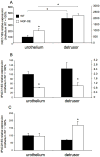

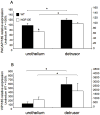
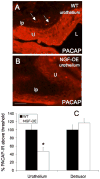
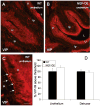
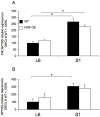
Similar articles
-
Effects of CYP-induced cystitis on PACAP/VIP and receptor expression in micturition pathways and bladder function in mice with overexpression of NGF in urothelium.J Mol Neurosci. 2012 Nov;48(3):730-43. doi: 10.1007/s12031-012-9834-1. Epub 2012 Jun 15. J Mol Neurosci. 2012. PMID: 22700375 Free PMC article.
-
PACAP-mediated ATP release from rat urothelium and regulation of PACAP/VIP and receptor mRNA in micturition pathways after cyclophosphamide (CYP)-induced cystitis.J Mol Neurosci. 2008 Nov;36(1-3):310-20. doi: 10.1007/s12031-008-9104-4. Epub 2008 Jun 19. J Mol Neurosci. 2008. PMID: 18563302 Free PMC article.
-
Intravesical PAC1 Receptor Antagonist, PACAP(6-38), Reduces Urinary Bladder Frequency and Pelvic Sensitivity in NGF-OE Mice.J Mol Neurosci. 2016 Jun;59(2):290-9. doi: 10.1007/s12031-016-0764-1. Epub 2016 May 4. J Mol Neurosci. 2016. PMID: 27146136 Free PMC article.
-
The role of vasoactive intestinal polypeptide and pituitary adenylate cyclase-activating polypeptide in the neural pathways controlling the lower urinary tract.J Mol Neurosci. 2008 Nov;36(1-3):227-40. doi: 10.1007/s12031-008-9090-6. Epub 2008 Aug 2. J Mol Neurosci. 2008. PMID: 18677446 Free PMC article. Review.
-
Vasoactive intestinal peptide/pituitary adenylate cyclase activating polypeptide, and their receptors and cancer.Curr Opin Endocrinol Diabetes Obes. 2016 Feb;23(1):38-47. doi: 10.1097/MED.0000000000000218. Curr Opin Endocrinol Diabetes Obes. 2016. PMID: 26702849 Free PMC article. Review.
Cited by
-
Effects of CYP-Induced Cystitis on Growth Factors and Associated Receptor Expression in Micturition Pathways in Mice with Chronic Overexpression of NGF in Urothelium.J Mol Neurosci. 2016 Aug;59(4):531-43. doi: 10.1007/s12031-016-0774-z. Epub 2016 Jun 3. J Mol Neurosci. 2016. PMID: 27259880 Free PMC article.
-
Effects of CYP-induced cystitis on PACAP/VIP and receptor expression in micturition pathways and bladder function in mice with overexpression of NGF in urothelium.J Mol Neurosci. 2012 Nov;48(3):730-43. doi: 10.1007/s12031-012-9834-1. Epub 2012 Jun 15. J Mol Neurosci. 2012. PMID: 22700375 Free PMC article.
-
Differential Influences of Endogenous and Exogenous Sensory Neuropeptides on the ATP Metabolism by Soluble Ectonucleotidases in the Murine Bladder Lamina Propria.Int J Mol Sci. 2023 Oct 27;24(21):15650. doi: 10.3390/ijms242115650. Int J Mol Sci. 2023. PMID: 37958631 Free PMC article.
-
Mechanisms and regulation of neurotrophin synthesis and secretion.Neurosciences (Riyadh). 2016 Oct;21(4):306-313. doi: 10.17712/nsj.2016.4.20160080. Neurosciences (Riyadh). 2016. PMID: 27744458 Free PMC article. Review.
-
Remote control of renal physiology by the intestinal neuropeptide pigment-dispersing factor in Drosophila.Proc Natl Acad Sci U S A. 2012 Jul 24;109(30):12177-82. doi: 10.1073/pnas.1200247109. Epub 2012 Jul 9. Proc Natl Acad Sci U S A. 2012. PMID: 22778427 Free PMC article.
References
-
- Abramoff MD, Magelhaes PJ, Ram SJ. Image processing with ImageJ. Biophotonics International. 2004;11(7):36–42.
-
- Andres R, Herraez-Baranda LA, Thompson J, Wyatt S, Davies AM. Regulation of sympathetic neuron differentiation by endogenous nerve growth factor and neurotrophin-3. Neurosci Lett. 2008;431(3):241–246. - PubMed
-
- Arimura A. Pituitary adenylate cyclase activating polypeptide (PACAP): discovery and current status of research. Regul Pept. 1992;37(3):287–303. - PubMed
-
- Arimura A. Perspectives on pituitary adenylate cyclase activating polypeptide (PACAP) in the neuroendocrine, endocrine, and nervous systems. Jpn J Physiol. 1998;48(5):301–331. - PubMed
-
- Arimura A, Somogyvari-Vigh A, Miyata A, Mizuno K, Coy DH, Kitada C. Tissue distribution of PACAP as determined by RIA: highly abundant in the rat brain and testes. Endocrinology. 1991;129(5):2787–2789. - PubMed
Publication types
MeSH terms
Substances
Grants and funding
LinkOut - more resources
Full Text Sources
Other Literature Sources
Medical

